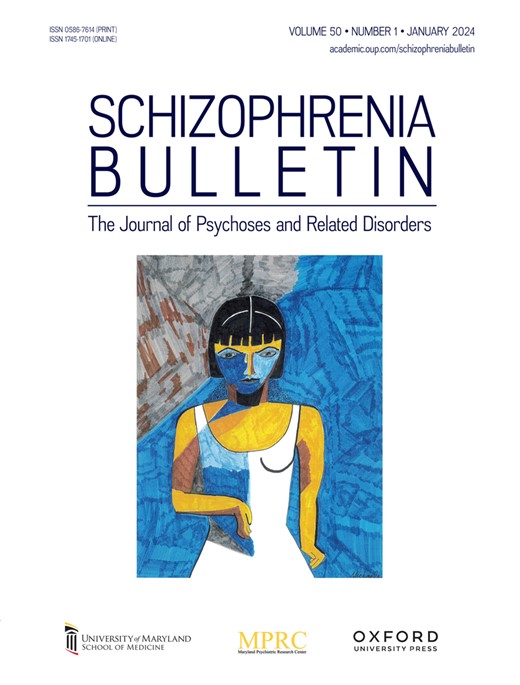精神分裂症多基因风险调节与脑结构连通性的差异关联
IF 5.3
1区 医学
Q1 PSYCHIATRY
引用次数: 0
摘要
目的 精神分裂症作为一种精神病易感性标记有助于精神分裂症谱系模型的研究,将精神病的表型风险与大脑结构和功能变异联系起来。然而,与结构连接组标记相关的研究非常有限,而且往往不考虑与遗传风险的关系。我们测试了这样一个假设:精神分裂症的各个层面(而非总体表型风险负担)与纤维束完整性有关,并且这与多基因精神分裂症风险(或恢复力)有关。设计 我们在 346 名精神健康受试者的队列中获得了弥散张量成像、使用牛津-利物浦感觉和体验量表(O-LIFE)进行的精神分裂症型分析,以及精神分裂症风险和抗精神分裂症能力的多基因风险评分(PRS)。通过使用 FSL 和 TBSS(基于束的空间统计),我们首先分析了 O-LIFE 与丘脑前辐射、钩状束和齿状束的分数各向异性(FA)之间的关联,以及与 PRS 评分之间的调节分析。结果 O-LIFE维度与结构连通性有不同的关联,尤其是阴性精神分裂症与右侧钩状束FA呈正相关,阳性精神分裂症与右侧钟状束呈负相关,而无序精神分裂症与左侧钟状束呈负相关。在无序型精神分裂症中,精神分裂症 PRS 可调节这种关联。结论 我们的研究结果支持精神病易感性结构连通性的神经生物学连续体模型,强调了与不同精神分裂症面的不同关联。然而,遗传性精神分裂症风险似乎只对其中的部分关联产生影响,因此需要进一步研究以了解其他遗传和/或环境因素的作用。本文章由计算机程序翻译,如有差异,请以英文原文为准。
Differential Association of Schizotypy Dimensions With Brain Structural Connectivity and Moderation by Schizophrenia Polygenic Risk
Objective Schizotypy as a psychosis proneness marker has facilitated the study of schizophrenia spectrum models, linking phenotypic psychosis risk to brain structural and functional variation. However, association studies to structural connectome markers are limited and often do not consider relations to genetic risk. We tested the hypothesis that dimensions of schizotypy (rather than overall phenotype risk burden) are related to fiber tract integrity and that this is moderated by polygenic schizophrenia risk (or resilience). Design In a cohort of 346 psychiatrically healthy subjects, we obtained diffusion tensor imaging, schizotypy using O-LIFE (Oxford-Liverpool Inventory of Feelings and Experiences), and polygenic risk scores (PRS) for schizophrenia risk and resilience to schizophrenia. Using FSL and TBSS (tract-based spatial statistics), we first analyzed the association between O-LIFE and fractional anisotropy (FA) for the anterior thalamic radiation, uncinate fascicle, and cingulum bundle, as well as moderation analyses with PRS scores. Results O-LIFE dimensions were differentially associated with structural connectivity, in particular, negative schizotypy positively to right uncinate FA, positive schizotypy negatively to right cingulum and disorganized schizotypy negatively to left cingulum. In disorganized schizotypy the association was moderated by schizophrenia PRS. Conclusions Our results support a neurobiological continuum model of structural connectivity across psychosis proneness, emphasizing differential association with different schizotypy facets. Genetic schizophrenia risk, however, appears to impact only some of these associations, highlighting the need for further studies to understand the contribution of other genetic and/or environmental factors.
求助全文
通过发布文献求助,成功后即可免费获取论文全文。
去求助
来源期刊

Schizophrenia Bulletin
医学-精神病学
CiteScore
11.40
自引率
6.10%
发文量
163
审稿时长
4-8 weeks
期刊介绍:
Schizophrenia Bulletin seeks to review recent developments and empirically based hypotheses regarding the etiology and treatment of schizophrenia. We view the field as broad and deep, and will publish new knowledge ranging from the molecular basis to social and cultural factors. We will give new emphasis to translational reports which simultaneously highlight basic neurobiological mechanisms and clinical manifestations. Some of the Bulletin content is invited as special features or manuscripts organized as a theme by special guest editors. Most pages of the Bulletin are devoted to unsolicited manuscripts of high quality that report original data or where we can provide a special venue for a major study or workshop report. Supplement issues are sometimes provided for manuscripts reporting from a recent conference.
 求助内容:
求助内容: 应助结果提醒方式:
应助结果提醒方式:


